Ames W.F., Harrel E.M., Herod J.V. (editors). Differential Equations with Applications to Mathematical Physics
Подождите немного. Документ загружается.

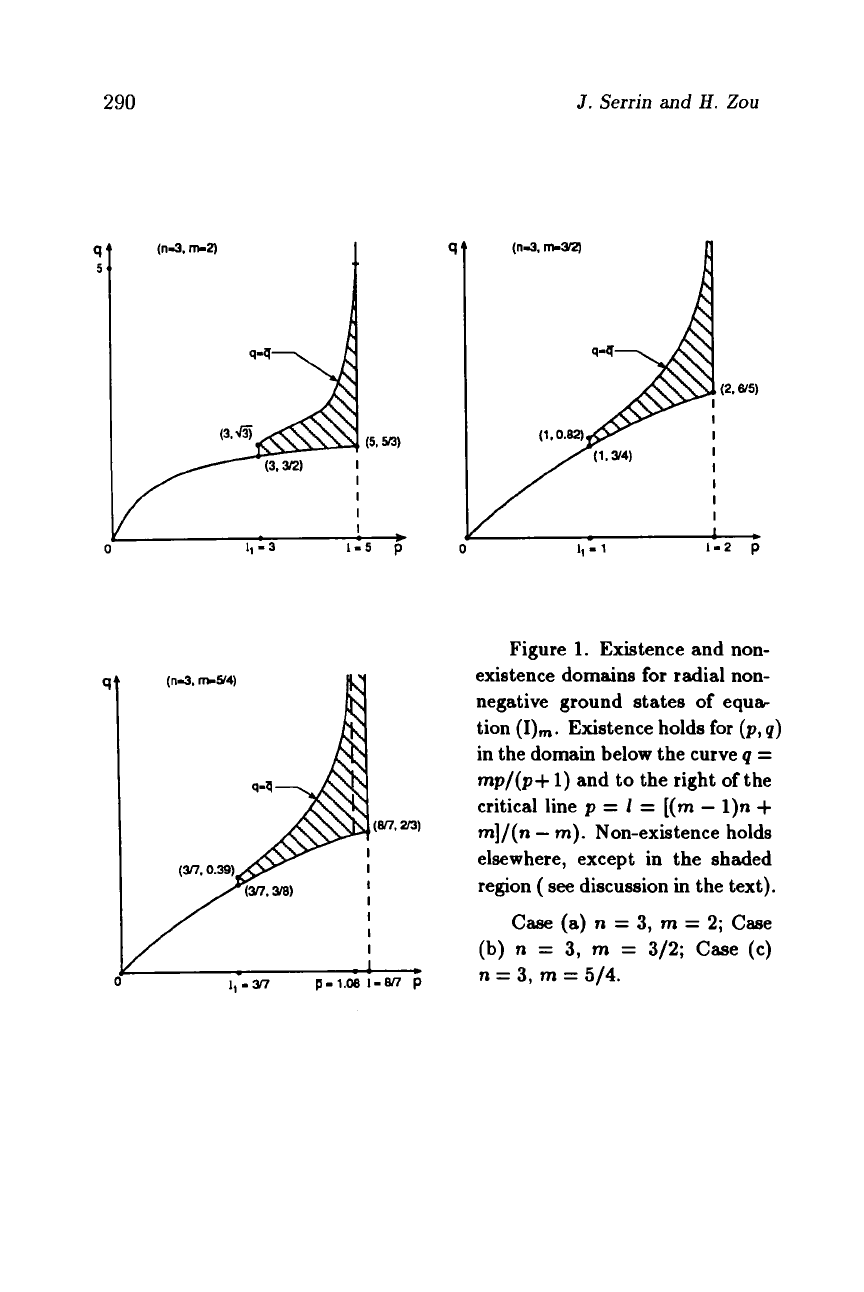
290
J.
Serrin
and
H.
Zou
4
f
I
b
I,
-
3
1-5
p
I
I
I
1.
1.2
p
/-
I,
-
1
Figure
1.
Existence and non-
existence domains for radial non-
negative ground states of eqult
tion
(I),.,,.
Existence holds for
(p,
q)
in the domain below the curve
q
=
mp/(p+
1)
and to the right of the
critical line
p
=
1
=
[(m
-
1).
+
m]/(n
-
m).
Non-existence holds
elsewhere, except in the shaded
region
(
see
discussion in the text).
Case (a)
n
=
3,
m
=
2; Case
(b)
n
=
3,
m
=
3/2; Case
(c)
n
=
3,
m
=
514.
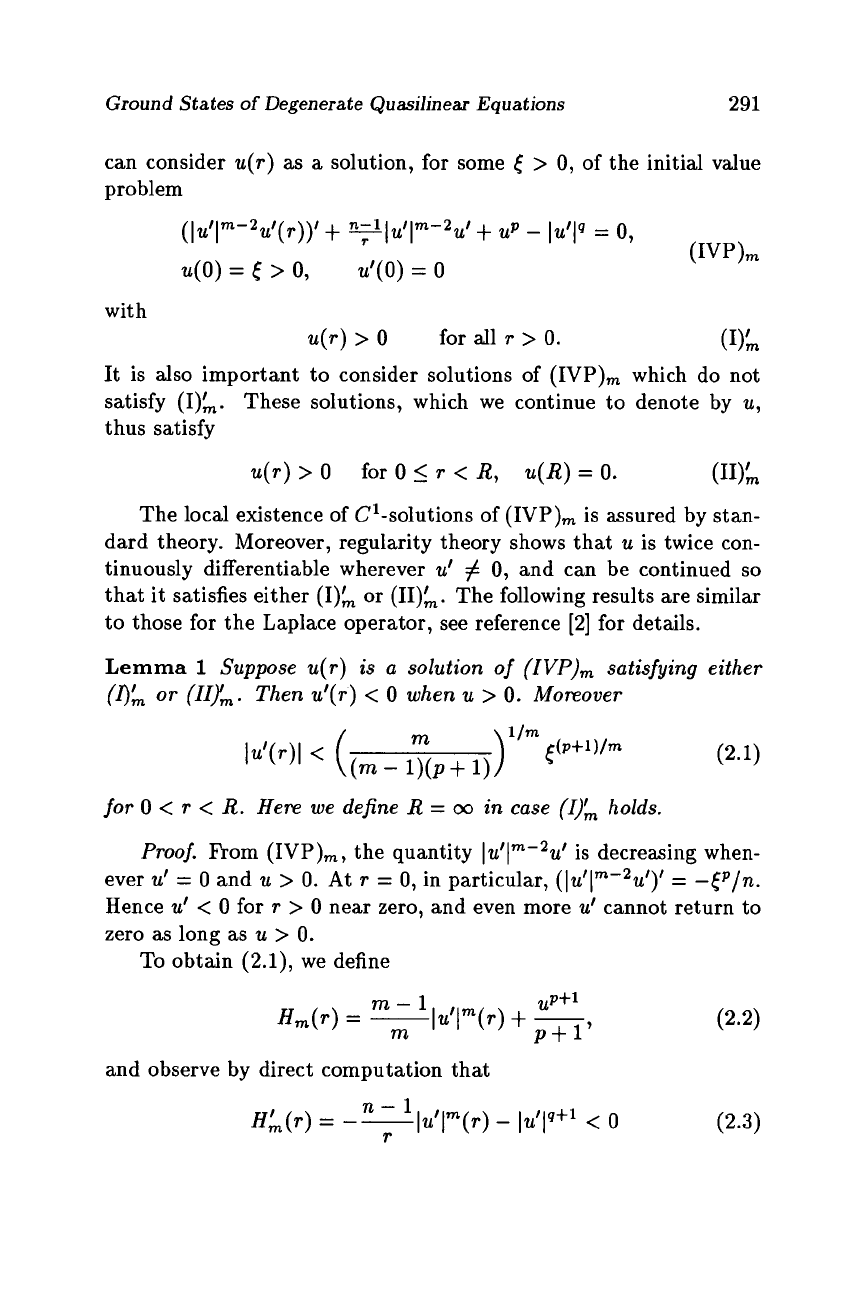
Ground States
of
Degenerate Quasilinear Equations
291
can consider
u(r)
as
a
solution, for some
6
>
0,
of the initial value
problem
(Iu’lm-2u’(r))’
+
+IU‘I~-~U’
+
up
-
Iu’Iq
=
0,
u(0)
=
6
>
0,
u‘(0)
=
0
(IVP)m
with
u(r)
>
0
for all
r
>
0.
(1);
It is also important to consider solutions of (IVP), which do not
satisfy
(I);.
These solutions, which we continue to denote by
u,
thus satisfy
u(r)
>
0
for
0
5
r
<
R,
u(R)
=
0.
(11);
The local existence of C1-solutions
of
(IVP), is assured by stan-
dard theory. Moreover, regularity theory shows that
u
is twice con-
tinuously differentiable wherever
u’
#
0,
and can be continued
so
that it satisfies either (I);
or
(11);. The following results are similar
to
those for the Laplace operator, see reference
[2] for
details.
Lemma
1
Suppose
u(r)
is
a
solution of
(IVP),
satisfying either
(4;
or
(IIym.
Then
u‘(r)
<
0
when
u
>
0.
Moreover
for
0
<
r
<
R.
Here
we
define
R
=
00
in
case
(I,),
holds.
ProoJ
From (IVP),, the quantity
IU’J~-~U’
is decreasing when-
ever
u’
=
0
and
u
>
0.
At
r
=
0,
in particular,
(IU‘~~-~U’)’
=
-(P/n.
Hence
u’
<
0
for
T
>
0
near zero, and even more
u‘
cannot return to
zero as long as
u
>
0.
To obtain
(2.1),
we define
m-1
UP+1
H,(T)
=
-Iu’~~(T)
+
-
m
p+
1’
and observe by direct computation that
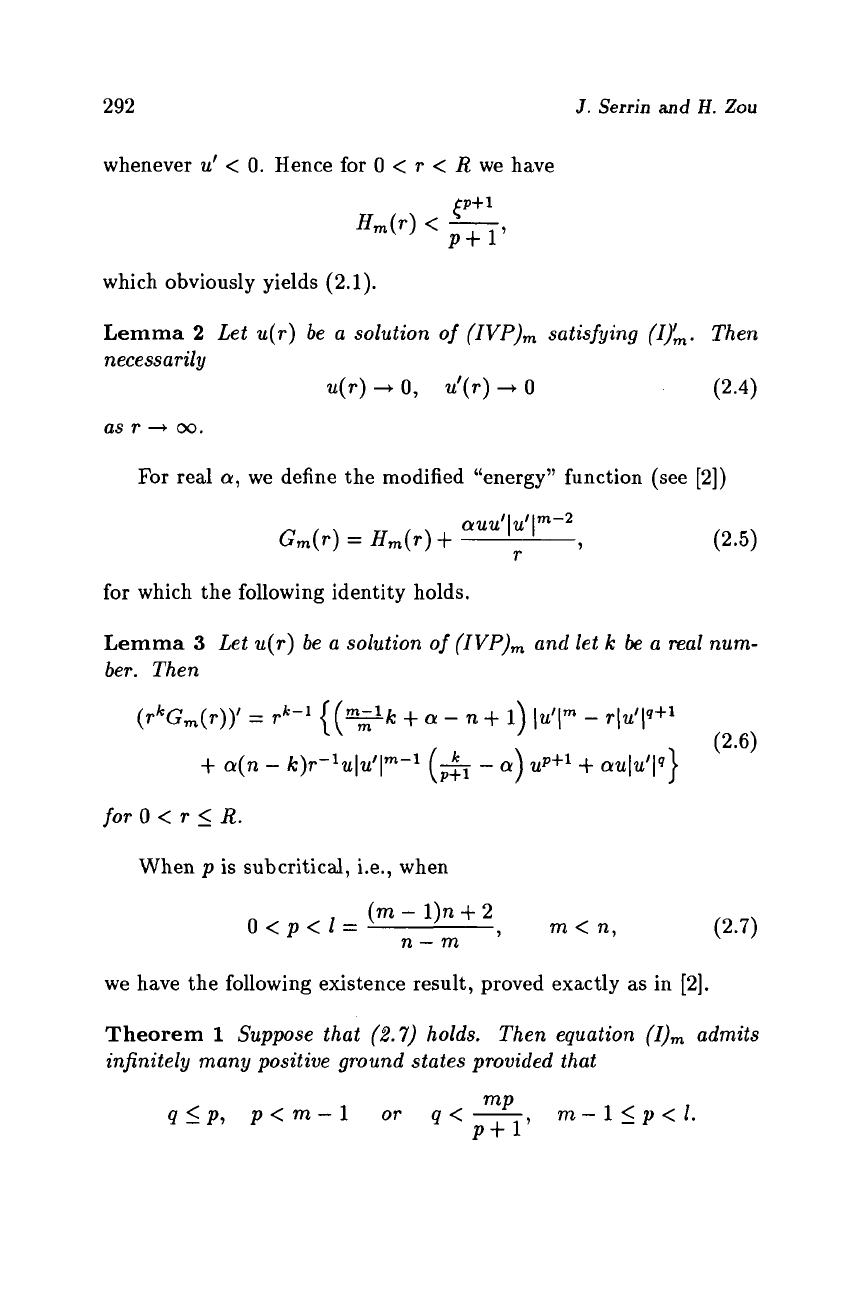
292
J.
Serrin
and
H.
Zou
whenever
u’
<
0.
Hence
for
0
<
r
<
R
we have
which obviously yields
(2.1).
Lemma
2
Let u(r) be
a
solution
of
(IVP),
satisfying
(&Im.
Then
necessarily
u(r)
+
0,
d(r)
+
o
(2.4)
asr-oo.
For
real
a,
we define
the
modified “energy” function (see
[a])
for which the following identity holds.
Lemma
3
Let u(r) be
a
solution
of
(IVP),
and let
k
be
a real num-
ber. Then
(rkG,(r))’
=
rk-’
{
(%k
+
a
-
n
+
1)
Iu’lm
-
r(u‘(q+l
+
a(n
-
k)r-1uIu’lm-l
(&
-
a)
up+1+
oulttlq}
(2.6)
for
0
<
r
5
R.
When
p
is
subcritical, i.e., when
(m
-
1).
+
2
O<p<l=
,
m<n,
n-m
(2.7)
we have the following existence result, proved exactly as
in
[2].
Theorem
1
Suppose that
(2.7)
holds. Then equation
(I),
admits
infinitely many positive ground states provided that
qsp, p<m-1 or q<-
mp
m-l<p<l.
p+
1’

Ground States
of
Degenerate Quasilinear Equations
293
3
Existence
of
Ground States
Here we obtain the existence of ground states for equation (I), in
the supercritical case. Since (I)m has
a
radially symmetric structure,
we seek in particular the existence of radial ground states.
As
is
customary, we consider the initial value problem (IVP), and use an
ODE
shooting argument to find the desired solutions.
Theorem
A
(i)
If
then
for
each
(
>
0
equation
(I)m
has a unique positive radial ground
state
u(r)
with central value
u(0)
=
<
(that is,
lulp
=
0.
(ii)
If
m(n
-
1)P
mn
+
(m
-
l)(p
+
1)'
p>l and q>
then
for
all suficiently small
(
>
0,
equation
(I)m
has a unique
positive radial ground state
u(r)
with central value
u(0)
=
<.
The proof
of
Theorem
A
is almost the same as in
[2],
the following
PPS (Pohozaev-Pucci-Serrin) type identity for solutions of (IVP),
being the main tool
for
the argument.
Proposition
1
Let
u
be a solution
of
(IVP),
satisfying
(IIY,.
Then
for
all real numbers
a
and
for
k
>
0
we have
+(--kto
m-1
m
In order to apply
(3.1)
we shall
alization of the well-known Poincard
2).
also need the following gener-
inequality (see
[2],
Proposition

294
J.
Serrin
and
H.
Zou
Proposition
2
Let
R
c
Rn
be
bounded with smooth boundary. Sup-
pose that
u
E
C1(R)
n
Co(fi)
with
u
=
0 on
dR.
Then
for
0
<
q
<
k,
Finally, see
[2],
Lemma
4,
we have
Lemma
4
Suppose that
u
is a solution
of
(IVP),
satisfying
(II,,,,
with
q
>
mp/(p
+
1).
Then, provided that
(
5
1,
we have
where
s
=
[q(p
+
1)
-
mp]/2
>
0.
Sketch ofproof
of
Theorem
A.
Consider solutions of (IVP),. Our
goal is to show that
for
appropriate initial values
(
>
0
a
solution
u(~)
can never reach zero at
a
finite value of
r,
i.e.,
u(r)
exists and
stays positive
for
all
r
>
0.
If
this is done then the theorem will be
proved, for by Lemma
2
the function
u(r)
must tend to zero as
r
goes to infinity and consequently
u
must be
a
positive ground state
with central value
(.
The proof is by contradiction. If
U(T)
reaches zero
at
a
finite
point
R,
then choosing
k
a=-
m(n
-
l)(P
+
1)
k=
m+(m-i)(p+q7
p+
1’
we obtain
a
direct contradiction with
(3.1)
and
(3.2)
in case (i), while
in case (ii) we choose
k
=
n
and
a
=
k/(p
+
1)
and use
(3.1)
and
(3.3).
For
details, the reader is referred to
[2].
4
A
Fundamental Identity
In this section we prove an identity for solutions
of
(IVP), which
will be crucial for the remaining results in the paper. Let
u(r)
be
a

Ground States
of
Degenerate Quasilinear Equations
295
solution of
(IVP),
and
R
=
R(()
the first positive
zero
of
u
(if
u
>
0
for all
r,
then
R
=
00).
For
k,
a,
P
E
R,
consider the function
Zm(r)
=
rkG,(r)
-
Prk~I~’Iq,
0
<
T
<
R,
(4.1)
where
Gm(r)
is given by
(2.5).
Lemma
5
Suppose that
u(r)
is
a
solution
of
(IVP),
and let
Then
Z,(r)
satisfies the initial value problem
z;(T)
+
eldlq-lzm(T)
=
qT),
~m(0)
=
0,
(4.3)
K(r)
=
CrIC-2u1u’lm-1(a
+
bX
+
cX2)
(4.4)
2
0,
where
8
=
Pq(p
+
l)/(m
-
1)
and
with
and
m
n-1
c
=-
m
-
1
[m
+
(m
-
l)(p
+
1)y
In
particular
ds.
(4.5)
-e
so‘‘
luip+l--mdg
Jd
I((s)eeJos
lu’p+l-mdt
Proof.
Equation
(4.3),
with
(4.4)
and
(4.5),
was proved in
[2]
for
m
=
2. The proof for arbitrary
m
>
1
is based on the following
identity for any
k,
a,
P,
8
E
R
Z,(r)
=
e
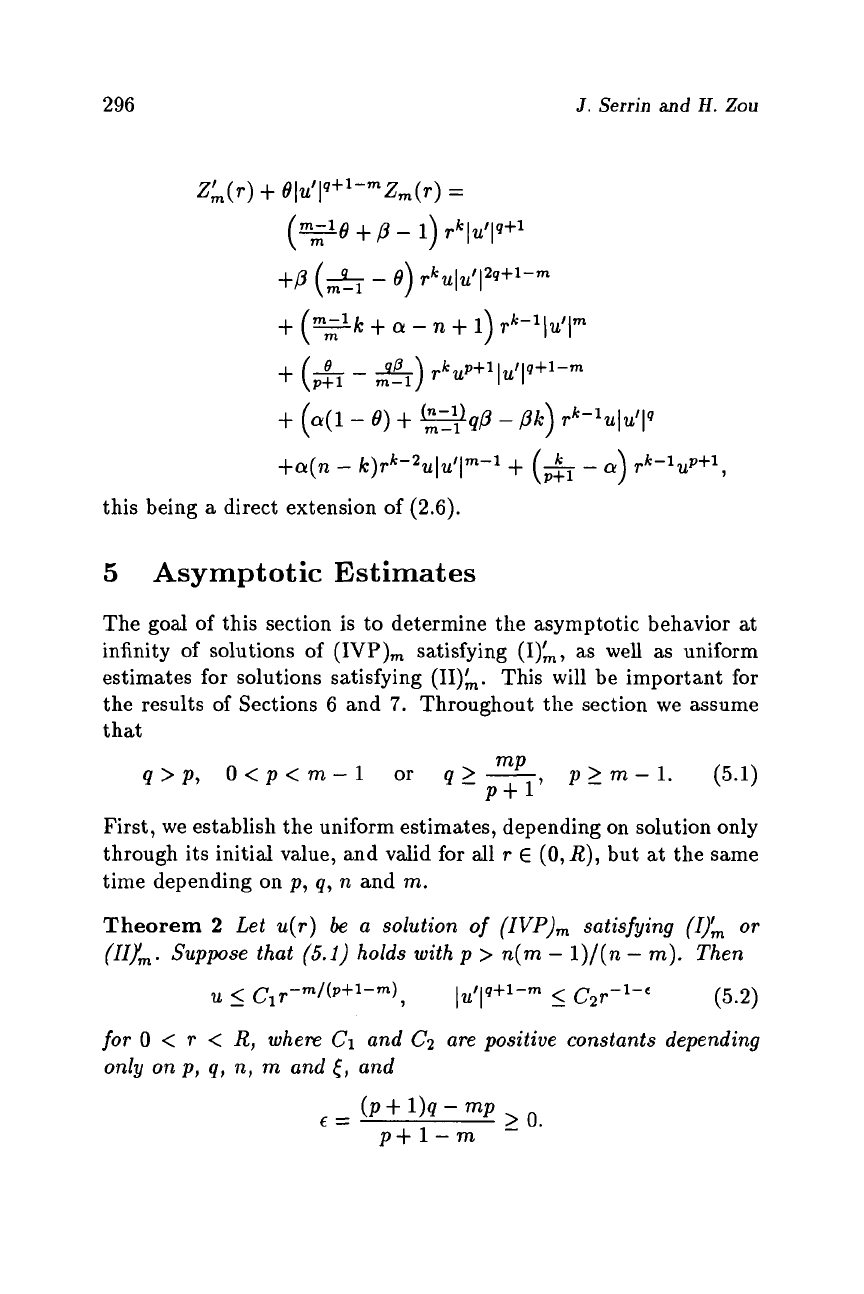
296
J.
Serrin
and
H.
Zou
5
Asymptotic Estimates
The goal of this section is to determine the asymptotic behavior
at
infinity of solutions of
(IVP),
satisfying
(I);,
as
well
as uniform
estimates for solutions satisfying
(1I)L.
This will be important for
the results of Sections
6
and
7.
Throughout the section we assume
that
q>p, O<p<m-1
or
q>-
mp
p
2
m-
1.
(5.1)
First, we establish the uniform estimates, depending on solution only
through its initial value, and valid for
all
r
E
(0,
R),
but
at
the same
time depending on
p,
q,
n
and
m.
Theorem
2
Let
U(T)
be
a
solution
of
(IVP),
satisfying
(1ym
or
(IIY,.
Suppose that
(5.1)
holds with
p
>
n(m
-
1)/(
n
-
m).
Then
p+
1'
U
-
<
clr-"/(P+l-")
,
IU'(P+l-m
5
C2r-l-'
(5.2)
for
0
<
T
<
R,
where
C1
and
C2
are positive constants depending
only on
p,
q,
n,
m
and
[,
and
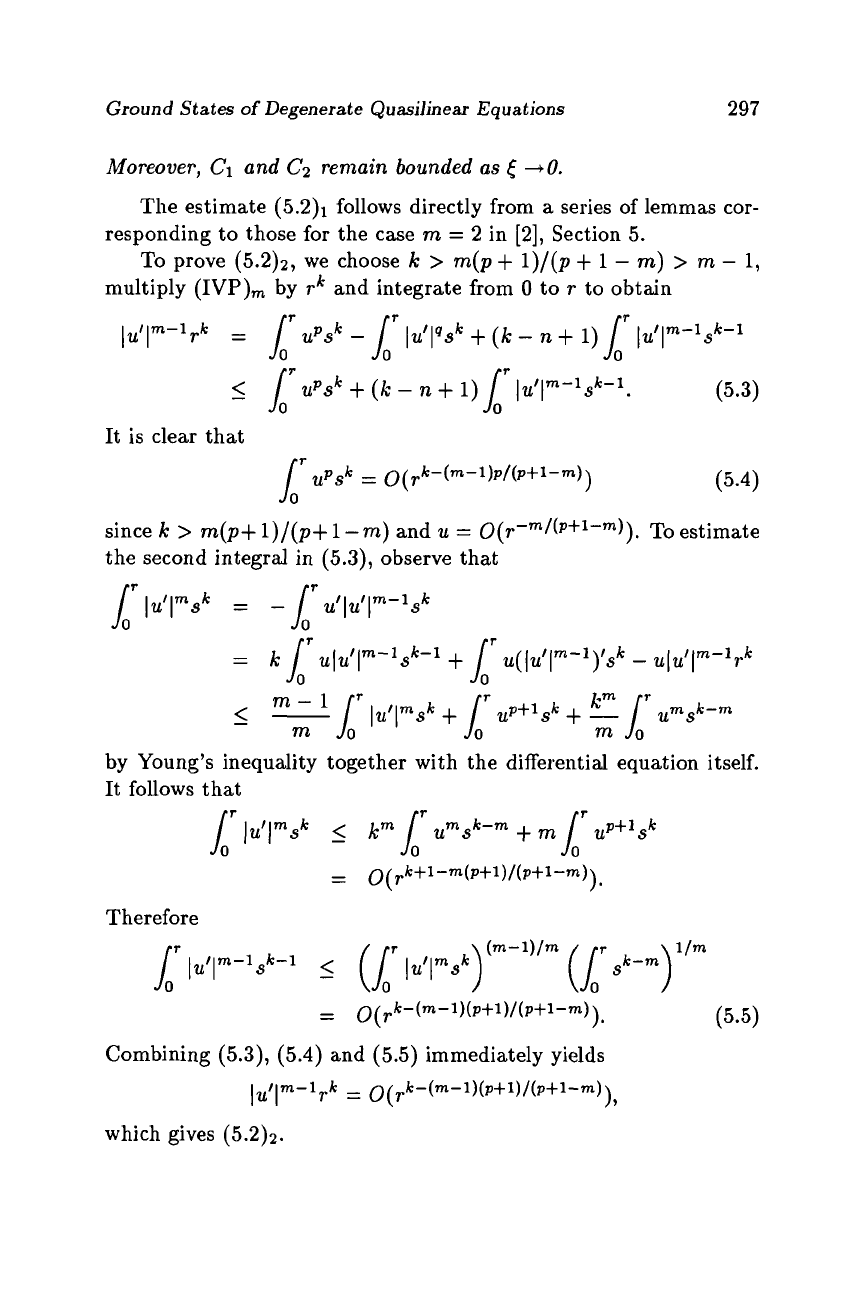
Ground States
of
Degenerate Quasilinear Equations
297
Moreover,
C1
and
C2
remain bounded as
E
-to.
The estimate
(5.2)1
follows directly from
a
series of lemmas cor-
To
prove
(5.2)2,
we choose
k
>
m(p
+
l)/(p
+
1
-
m)
>
m
-
1,
responding to those for the case
m
=
2
in
[2],
Section
5.
multiply
(IVP),
by
rk
and integrate from
0
to
r
to obtain
It is clear that
1
(5.4)
since
k
>
m(p+
l)/(p+
1
-
m)
and
u
=
O(T-"/(~+~-")).
To estimate
the second integral in
(5.3)'
observe that
by Young's inequality together with the differential equation itself.
It follows that
Therefore
Combining
(5.3)' (5.4)
and
(5.5)
immediately yields
~~llm-l~k
=
O(rk-(m-l)(p+')/(p+'-m)),
which gives
(5.2)~.

298
J.
Serrin and
H.
Zou
Theorem
3
Suppose that
u(r)
is
a
solution of (IVP) satisfying (I);,
and
that
(5.1)
holds. Then
(a) If
p
<
m
-
1,
there is no solution;
(b)
If
p
=
m
-
1,
then
u
=
O(e-T),
u'
=
O(e-T) as
r
---f
00;
(c) If
p
>
m
-
1,
then
u
=
o(r-"/(P+'-")
1,
u'
=
O(r-(p+')/(p+'-m)
1
The proof is essentially the same as for Theorem
2,
cf.
[2],
Section
6.
As
a
consequence of Theorem
3,
we
also
have the following lower
asymptotic estimate for ground states.
Corollary
1
Suppose p
2
m
-
1
and
q
>
mp/(p
+
1).
Then
<
00.
r
'u'Iq+l-m
(5.6)
Moreover, there exists
a
constant
p
>
0
such that
where
c
is
a
positive constant.
Pro05
(5.6) is
a
direct consequence of Theorem
3.
To prove (5.7),
we notice that from
(IVP)
I
qt1--m
It follows that the function
~u'~"+2u'(r)rn-1e~or
Iu
I
is decreas-
ing. In turn
Iu'lm-2u'(r)rn-1
tends to
a
negative (possibly infinite)
limit by
(5.6),
since
u'
<
0.
We then infer (5.7) by integration.
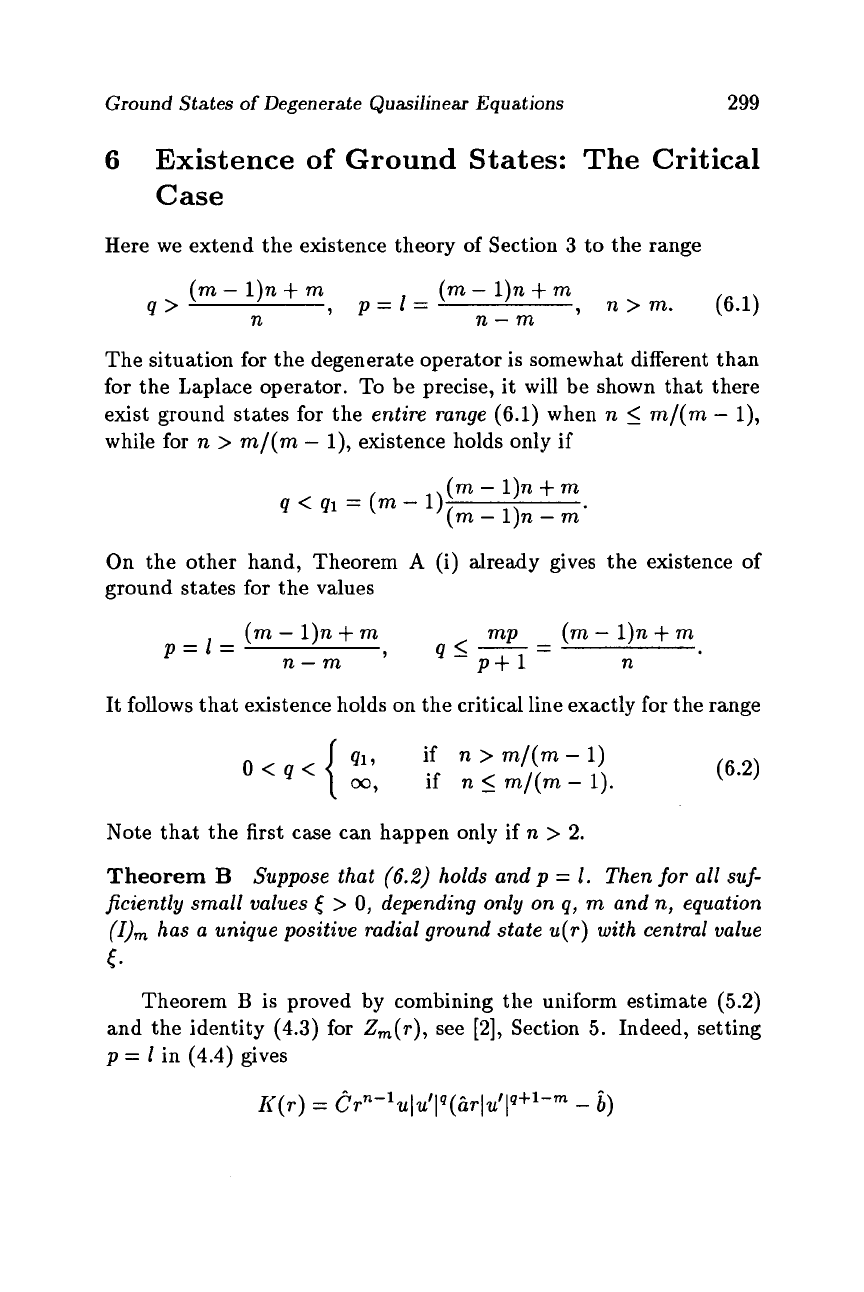
Ground
States
of
Degenerate Quasilinear Equations
299
6
Existence
of
Ground States: The Critical
Case
Here we extend the existence theory of Section
3
to the range
(m
-
1).
t
m
(m
-
1).
+
m
,
p=l=
,
n
>
m.
(6.1)
n n-m
Q>
The situation for the degenerate operator is somewhat different than
for
the Laplace operator. To be precise, it will be shown that there
exist ground states for the
entire range (6.1)
when
n
m/(m
-
l),
while for
n
>
m/(m
-
l),
existence holds only if
(m
-
1).
+
m
Q
<
41
=
(m
-
-
l)n
-
On the other hand, Theorem
A
(i) already gives the existence of
ground states for the values
It follows that existence holds on the critical line exactly for the range
q1,
if
n
>
m/(m-
1)
00,
if
n
5
m/(m-
1).
Note that the first case can happen only if
n
>
2.
Theorem
B
Suppose that
(6.2)
holds and p
=
1.
Then for all suf-
ficiently small values
<
>
0,
depending only on
q,
m
and
n,
equation
(I)m
has a unique positive radial ground state
u(r)
with central value
<*
Theorem
B
is proved by combining the uniform estimate
(5.2)
and the identity
(4.3)
for
Zm(r),
see
[2],
Section
5.
Indeed, setting
p
=
1
in
(4.4)
gives
K(r)
=
~rn-luIu’IQ(iLrIu’lQ+l-m
-
6)
